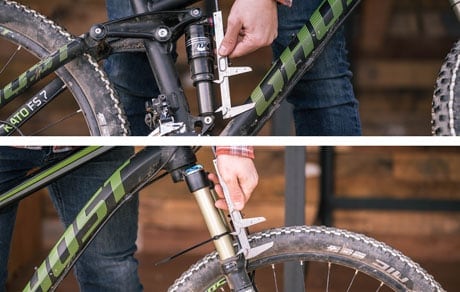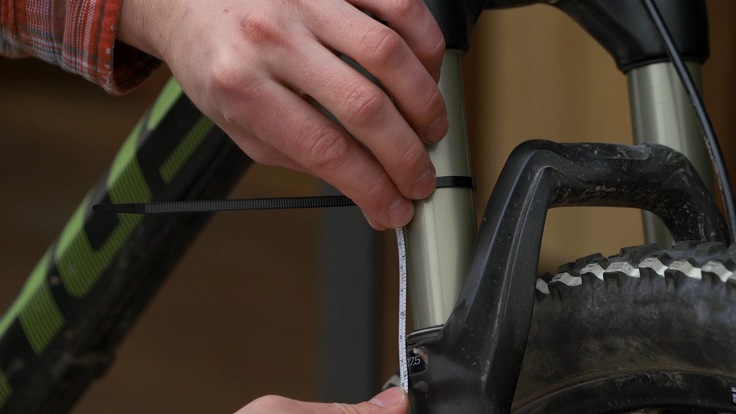If your bike has shocks, you'll need to calibrate the sag to get the best ride performance. Sag is the amount the shocks move under the weight of your body, bike shoes, helmet any other gear you carry when you're just sitting on the bike. Having it properly adjusted ensures the shocks are neither too stiff nor too soft.
Shop REI's selection of mountain bikes.
Video: Bike Maintenance: Setting Sag
Here are the tools you'll need:
- A ruler
- A shock pump
- A pen and paper
You also need to wear your backpack with water and any extra gear you normally carry while riding.
Some bikes come with sag calibration charts that help make calculations faster, but you don't need one. If you want to use a chart you can find one on the shock manufacturer's website.
Start by measuring and noting the length of both the front and rear shocks in millimeters. You'll use these numbers later.
Next make sure the shocks are switched open or are in descend mode. To make the next steps easier, find a bench or tree to lean against or have a friend handy to hold your bike steady.
Check both stanchions on your front fork for an O-ring. If you don't have one you can attach a zip tie to show how far the stanchion travels. It's important to set sag according to your riding weight so make sure to wear all your normal riding gear.
Now sit on the bike and bounce the suspension up and down several times to warm up the shocks. Get into your riding stance with all your weight over the bike then slide the O-ring down the stanchion on the fork and up the shaft on the rear shock. Carefully dismount the bike without bouncing the shocks. Now you can measure and record the distance between the O-ring and the body of the shock. This measurement is the shock's static travel.

Set the Sag
To calculate your sag percentage, divide the static travel by the total length of the shock and multiply by 100. Most manufacturers recommend that you set your sag somewhere between 25 to 35 percent. If your sag is higher or lower than that, you need to make some adjustments by attaching your shock pump and increasing or decreasing the air pressure in the shock and running the calculation again.
Sag is mostly a matter of personal preference, but if you ride fast over aggressive terrain, you'll want to keep your sag lower and on the firm side by adding air pressure. For a smoother ride on easier terrain, go for a softer setting by keeping the air pressure lower and the sag higher. Each time you change the pressure in the shock repeat the measuring process until your sag is just where you want it.
